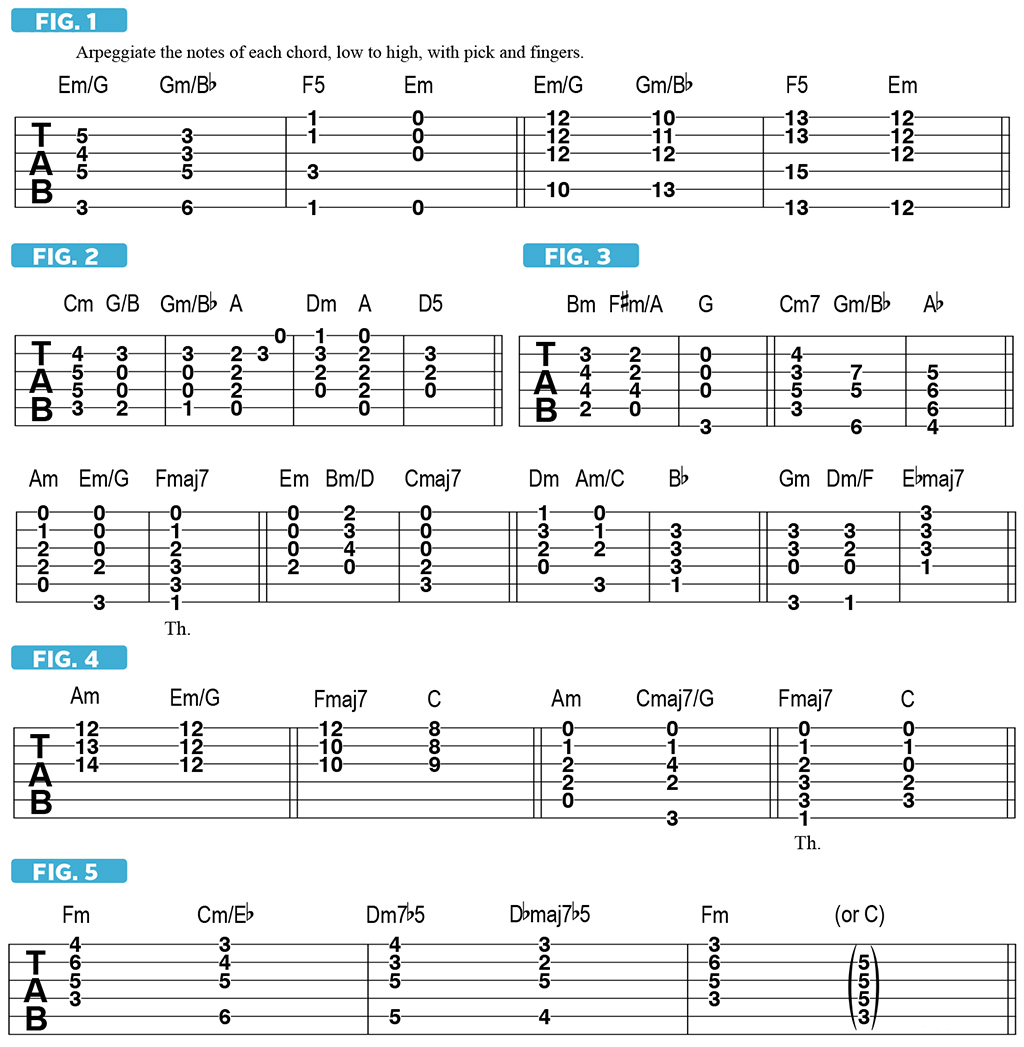The Sadly Warm First-Inversion Minor Chord
Learn more about the first-inversion minor chord, an invaluable resource for the aspiring composer.
Last month, we looked at some appealing ways in which famous songwriters have employed second-inversion major chords in the progressions behind some of their most popular and enduring melodies. I’d now like to reference a few brief but well-known examples of the use of a first-inversion minor chord, for which the minor third is the bass note. While not as commonly found in popular music as its major counterpart, the first-inversion minor chord has a uniquely dark quality that may be described as sadly warm, which makes it nonetheless an invaluable resource for the aspiring composer when looking for just the right chord to express that kind of feeling and emotion in an accompaniment to a melody.
Each verse to Soundgarden’s “Black Hole Sun” begins hauntingly with two back-to-back first-inversion minor chords, Em/G and Gm/Bb, the basic voicings of which are illustrated in FIGURE 1. For the sake of theoretical argument, each chord may alternatively be reckoned as a major six — G6 and Bb6 — although the absence of a fifth in each case (the notes D and F, respectively) makes this an either/or proposition. Anyway, note the contrary motion between the outer voices in the chord change, as the bass line ascends while the top note descends.

The slow, haunting interlude after the guitar solo in Radiohead’s “Paranoid Android” (beginning at 3:34) features a somber- sounding bass-drop progression that begins on Cm, then goes to a first-inversion major chord, G/B, followed by a “sag” to its parallel-minor counterpart, Gm/Bb, then A, which resolves satisfyingly to Dm, as in FIGURE 2. Notice how the warmth of G/B gives way to the dark, or sad, warmth of Gm/Bb, which in turn is followed by the more hopeful-sounding A major chord. It’s all about placement.
Another effective way to use a first-inversion minor chord is to put it after a different minor chord that’s in root position, with the bass line dropping a whole step. This happens in Journey’s “Open Arms,” specifically during the second vocal phrase of the first verse, where pianist Jonathan Cain plays Bm then F#m/A, as opposed to a straight A chord, which he initially plays during this same part of the progression in the song’s intro and subsequent verses. The beautiful love song “Forever” by the Beach Boys provides another example of this move, with the third and fourth chords of the intro and each verse, where Cm7 is followed by Gm/Bb (as opposed to Eb/Bb, or a straight Bb). FIGURE 3 illustrates some nice ways to play this change, in both the above-mentioned songs’ original keys, and other guitar-friendly ones as well.
The chorus to “Let It Be” by the Beatles includes angelic, high background-vocal “ooh”s, which, on the second chord, C/G, convey an Em/G sound. But when heard with the rhythm section, this creates a gorgeous Cmaj7/G harmony overall, as demonstrated in FIGURE 4.
One more great example of a first-inversion minor chord in a classic rock song can be found in the melancholy intro to “Dream On” by Aerosmith, specifically at 0:13, on the second bass note, Eb, which bassist Tom Hamilton plays under a Cm chord. This movement, outlined in FIGURE 5, occurs again at 2:11 and 2:50, behind the lyric “just for today…”
Senior Music Editor "Downtown" Jimmy Brown is an experienced, working guitarist, performer and private teacher in the greater NYC area whose professional mission is to entertain, enlighten and inspire people with his guitar playing.
All the latest guitar news, interviews, lessons, reviews, deals and more, direct to your inbox!
Over the past 30 years, Jimmy Brown has built a reputation as one of the world's finest music educators, through his work as a transcriber and Senior Music Editor for Guitar World magazine and Lessons Editor for its sister publication, Guitar Player. In addition to these roles, Jimmy is also a busy working musician, performing regularly in the greater New York City area. Jimmy earned a Bachelor of Music degree in Jazz Studies and Performance and Music Management from William Paterson University in 1989. He is also an experienced private guitar teacher and an accomplished writer.

